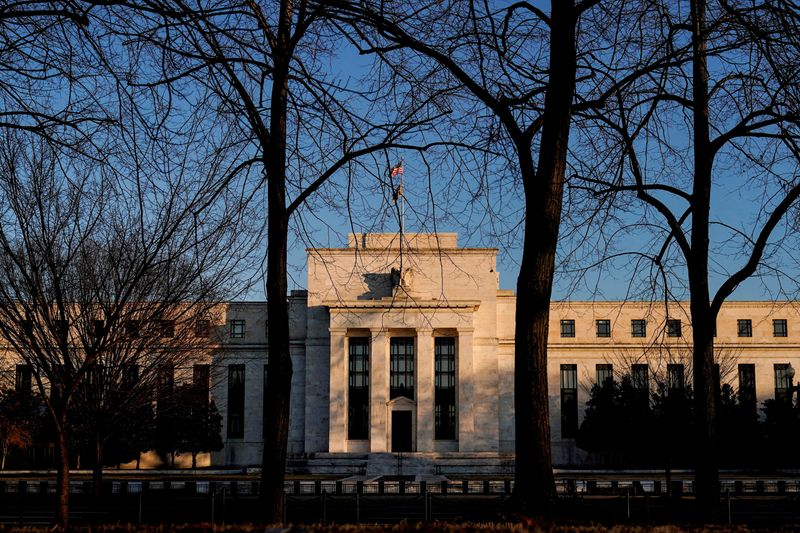By Mike Dolan
LONDON (Reuters) – There’s always the balance sheet.
Battered bond markets are frantically repricing government borrowing costs to levels not seen for decades, raising fears that these ructions may undermine broader markets and even economies.
The fundamental causes of the bond furore have been well aired: investor concern about sticky U.S. inflation, Federal Reserve interest rates and ballooning debt as a new U.S. presidential administration takes office.
But anxious investors seem to be forgetting that central banks still have an incredibly powerful tool available: their balance sheets.
Central banks are mandated to preserve financial stability. If they deem markets to be unjustifiably restive, they can mobilise their theoretically infinite balance sheets at any time.
While the last two years have seen several major central banks roll debt off their books and sell it outright in some cases, policymakers can always retreat if needed.
We have already seen this happen. The Bank of England temporarily reversed its balance sheet reduction to successfully stabilise the gilt market in late 2022. And the Fed did likewise during the regional bank wobble in March 2023.
What’s more, the Fed and other central banks already seem set to halt their balance sheet runoffs – or “quantitative tightening” (QT) – early this year. Analysts expect roughly half a trillion dollars more will be run off in the U.S. before the programme ends.
This runoff has yet to cause U.S. bank reserves to run short or disturb broader money market liquidity, according to a new New York Fed monitoring tool.
For reference, the Fed’s $6.9 trillion balance sheet – down from a peak of over $9 trillion in 2022 – now represents about 24% of nominal U.S. gross domestic product output. That’s 10 percentage points less than the peak but, extraordinarily after all the pandemic interventions, it’s actually below where it was 10 years ago.
BALANCE SHEET BALM?
The likely end of QT this year then partially clears the decks for emergency interventions, if deemed necessary.
That should also act as a balm for bonds if things got out of hand.
Former New York Fed boss Bill Dudley noted last year that once a sustainable balance sheet level is found, the holdings should be concentrated in bills and short-term paper. As any necessary interventions would likely occur at the long end and could be easily funded by maturing bills, it would mean the overall size of the balance sheet would not change during a rescue.
Still, the size of central bank balance sheets has clearly become politically sensitive.
And the post-pandemic consensus among monetary policymakers and governments alike is that the past 15 years of balance sheet expansion should be consigned to history, with every effort made to keep monetary policy and financial stability issues separate.
That may be easier said than done if things go sideways. And while markets may still get more volatile from here without spurring central bank action, the knowledge that this tool is available should remain a potentially powerful buffer.
PRE-GFC VISTA
Although the Federal Open Market Committee meeting minutes show the Fed did not discuss much about the balance sheet last month aside from a technical change to the reverse repo window, policymakers did note the market was pushing back its assumptions about when QT would end.
Some Fed officials have also addressed the balance sheet question in light of this year’s relentless bond selloff.
Intriguingly, Kansas City Fed boss Jeff Schmid said last week the size of the balance sheet is still putting downward pressure on market borrowing costs, begging the question on where bond yields might be if QT weren’t being wound down.
Schmid estimated that 10-year yields, which are near 4.8% for the first time in 14 months, would be somewhere “between 50 and 100 basis points lower” if the Fed’s balance sheet was substantially smaller.
It is also useful to look at the so-called term premium in the Treasury market, which has climbed back toward levels seen before the Fed balance sheet was first expanded around the 2008 banking crash.
The New York Fed’s estimate of the term premium on 10-year Treasury yields has returned to as high 65 basis points for the first time since 2014. But that’s far less than the average of 190 bps seen in the 20 years prior to 2008.
While “counterfactuals” are hard to prove, it is fair to say the hefty balance sheet is continuing to throw its weight around. And it’s also a safe bet that the Fed and other central banks will not be giving up the right to use these powerful tools any time soon.
The opinions expressed here are those of the author, a columnist for Reuters.
(By Mike Dolan; Editing by Jamie Freed)

